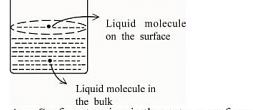Based on the given figure, the number of correct statement/s is/are _______

A. Surface tension is the outcome of equal attractive and repulsive forces acting on the liquid molecule in bulk
B. Surface tension is due to uneven forces acting on the molecules present on the surface
C. The molecule in the bulk can never come to the liquid surface
D. The molecules on the surface are responsible for vapour pressure if the system is a closed system

A. Surface tension is the outcome of equal attractive and repulsive forces acting on the liquid molecule in bulk
B. Surface tension is due to uneven forces acting on the molecules present on the surface
C. The molecule in the bulk can never come to the liquid surface
D. The molecules on the surface are responsible for vapour pressure if the system is a closed system
Correct Answer: 2
Solution and Explanation
The correct options are:
B: Surface tension arises due to uneven forces acting on the molecules present at the surface. Molecules at the surface of a liquid experience a net inward force because they are not surrounded by similar molecules on all sides. This imbalance results in the liquid's surface behaving as if it were under tension.
D: The molecules at the surface are responsible for vapor pressure in a closed system. In a closed system, molecules at the surface of the liquid are able to escape into the vapor phase, contributing to the vapor pressure. The equilibrium between the liquid and vapor phases determines the vapor pressure.
Top Questions on States of matter
- At T(K), a gaseous mixture contains H\(_2\) and O\(_2\). The total pressure of the mixture is 2 bar. The weight percentage (w/w) of H\(_2\) is 33.33%. What is the approximate ratio of partial pressure of H\(_2\) and O\(_2\)?
- AP EAPCET - 2025
- Chemistry
- States of matter
- The slope of isobar of one mole of an ideal gas at p (atm) is 0.082 L K$^{-1}$. What is the value of p in atm? (R=0.082 L atm mol$^{-1}$K$^{-1}$)
- TS EAMCET - 2025
- Chemistry
- States of matter
- Isotherms ($p$-$V$ lines) of one mole of an ideal gas at $T_1$ and $T_2$ have slope ratio 1:2. If $T_1=1000$ K, find $T_2$.
- TS EAMCET - 2025
- Chemistry
- States of matter
- At T(K) root mean square (rms) velocity of argon (molar mass 40 g mol⁻¹) is 20 ms⁻¹. The average kinetic energy of the same gas at T(K) (in J mol⁻¹) is
- TS EAMCET - 2025
- Chemistry
- States of matter
- Which of the following gases has the highest density at STP?
- VITEEE - 2025
- Chemistry
- States of matter
Questions Asked in JEE Main exam
A bob of mass \(m\) is suspended at a point \(O\) by a light string of length \(l\) and left to perform vertical motion (circular) as shown in the figure. Initially, by applying horizontal velocity \(v_0\) at the point ‘A’, the string becomes slack when the bob reaches at the point ‘D’. The ratio of the kinetic energy of the bob at the points B and C is:

- JEE Main - 2025
- Kinetic Energy
- 20 mL of 2 M NaOH solution is added to 400 mL of 0.5 M NaOH solution. The final concentration of the solution is \(\_\_\_\_\_\) x \(10^{-2}\)M. (Nearest integer)
- JEE Main - 2025
- Solutions
- If equal volumes of AB and XY (both are salts) aqueous solutions are mixed, which of the following combination will give precipitate of AY, at 300 K?
- JEE Main - 2025
- Solutions
- If \[ \lim_{x \to 0} \frac{\cos(2x) + a \cos(4x) - b}{x^4} \] is finite, then \( a + b = \) __.
- JEE Main - 2025
- Trigonometric Equations
- A vessel at 1000 K contains \( \text{CO}_2 \) with a pressure of 0.5 atm. Some of \( \text{CO}_2 \) is converted into \( \text{CO} \) on addition of graphite. If total pressure at equilibrium is 0.8 atm, then \( K_p \) is:
- JEE Main - 2025
- Equilibrium
Concepts Used:
States of Matter
The matter is made up of very tiny particles and these particles are so small that we cannot see them with naked eyes.
There are three States of Matter:
The three states of matter are as follows:
Solid State:
- The solid-state is one of the fundamental states of matter.
- Solids differ from liquids and gases by the characteristic of rigidity.
- The molecules of solids are tightly packed because of strong intermolecular forces; they only oscillate about their mean positions.
Liquid State:
- The molecules in a liquid are closely packed due to weak intermolecular forces.
- These forces are weaker than solids but stronger than that of gases.
- There is much space in between the molecules of liquids which makes their flowing ability easy.
Gaseous State:
- In this state of matter, distances between the molecules are large (intermolecular distance is in the range of 10-7-10-5 cm.
- The intermolecular forces experienced between them are negligible.
- Thus, translatory, rotatory and vibratory motions are observed prominently in gases.